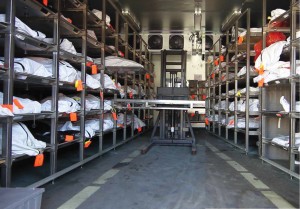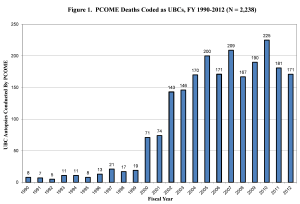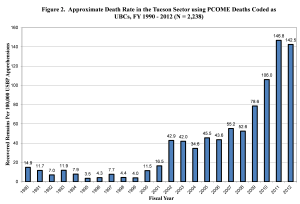 A recent report analyzing the deaths of undocumented border crossers along the Arizona-Mexico border finds that deaths have remained steady while border crossings have decreased dramatically. Based on an analysis of the remains of 2,238 migrants discovered between FY 1990 and 2012 and analyzed by the Pima County Office of the Medical Examiner, researchers have found that today’s migrants face more risks of death than ever before. Their data shows that the death rate doubled between 2009 and 2011.
A recent report analyzing the deaths of undocumented border crossers along the Arizona-Mexico border finds that deaths have remained steady while border crossings have decreased dramatically. Based on an analysis of the remains of 2,238 migrants discovered between FY 1990 and 2012 and analyzed by the Pima County Office of the Medical Examiner, researchers have found that today’s migrants face more risks of death than ever before. Their data shows that the death rate doubled between 2009 and 2011.
The report, titled “A Continued Humanitarian Crisis at the Border: Undocumented Border Crosser Deaths Recorded by the Pima County Office of the Medical Examiner, 1990-2012”, is compiled by the Binational Migration Institute of the University of Arizona and based on data from the Pima County Office of the Medical Examiner. The Pima County forensics team has investigated more than 95% of all migrant remains discovered in Arizona since 2003.
The report comes out at a crucial moment in the debate on immigration reform and border security policy. As the authors point out, “Understanding the causes and solutions of unauthorized migration and migrant deaths requires an understanding of the extent of these phenomena.”
The study offers empirical and fact-based evidence that current border security policies are a direct cause of the death of hundreds of men, women and children a year. Daniel Martinez, the lead author of the study, notes that 20% of the remains are identified as women and 6% of remains for which age is known were under 18.
How to avoid those deaths should be a central part of the current debate. It is a responsibility, not only for the border counties where migrants lose their lives, but also for the nation, whose policies must always seek to protect human life and rights.
“These are persons who die who come from countries that are our ‘friends’ not our enemies,” notes autor Raquel Rubio Goldsmith. “Adopting a rational visa system as well as a renegotiation of NAFTA, and other trade agreements as we implement some form of continental economic development program, we can put an end to the deaths of thousands of persons.”
Goldsmith adds, “The proposals coming out of the senate do not address these issues. Until they are brought into public discussion, we will not come close to resolving the immigration issues on the southern border.”
The Arizona report on border-crosser deaths is the outcome of a far-too-rare cooperation between government, academics and grassroots rights organizations. The Pima County Office of the Medical Examiner provided public information, while the university team worked to analyze the data with the help of community groups, notably the Coalición de Derechos Humanos (Human Rights Coalition), in Tucson.
The result is a report that should be required reading for lawmakers in the border region and in Washington, along with a similar report produced by Houston Unido on the sharp rise in border deaths in the Rio Grande sector.
Below are excerpts from the report and its major findings. The full report with citations can be found here.
_____
The deaths of hundreds of unauthorized migrants each year along the U.S.-Mexico border continue despite recent evidence that migration from Mexico has decreased dramatically over the past five years. This humanitarian crisis is a consequence of multiple interrelated and intersecting factors, 1) the long history and socially embedded culture of migration in many areas of Mexico, 2) neoliberal economic reform during 1990s that displaced hundreds of thousands of campesinos throughout the country, 3) inadequate U.S. immigration policies ill-equipped to deal with the reality of an increasingly globalized world, 4) border enforcement and securitization practices initially instituted in the mid-1990s that effectively pushed would-be migrants into the most remote, hot, and dry regions of the desert borderlands, and 5) the structurally embedded demand for immigrant labor in the United States.
The links between increased border security and migrant fatalities have been demonstrated extensively. The 1990s and 2000s saw dramatic increases in the fortification of the U.S.-Mexico border and simultaneous increases in reported migrant deaths. Segmented border militarization has resulted in the “funnel effect”, or the redistribution of migratory flows into remote and dangerous areas such as southern Arizona.
The Pima County Office of the Medical Examiner (PCOME), in Tucson, Arizona, continues to be the agency that investigates the highest number of migrant deaths in the country, and as a consequence, now handles more unidentified remains per capita than any other medical examiner’s office in the United States. Arizona now ranks third in the nation, following California and New York, for the number of unidentified remains entered into the National Missing and Unidentified Persons System (NamUs), but ranks first in probable migrant remains and known missing migrants.
The funnel effect has made the Tucson Sector the single most traversed crossing corridor for migrants along the entire U.S.-Mexico border. In Fiscal Year (FY) 2012, over 33% of all Border Patrol apprehensions occurred in the Tucson Sector, whereas between FY 1993 and 1996 less than 15% of all apprehensions took place in the same sector. It is precisely this redistribution of migration flows into southern Arizona that has led to an increase in migrant remains handled by the PCOME.
Estimated Number of Deaths
Between FY 1990 and 2012, the PCOME examined the remains of 2,238 migrants. Over a third of these decedents, or 761 cases, remained unidentified at the publication of this report, and thus their status as unauthorized migrants is predicted rather than certain. Beginning in 2001, the PCOME began to classify deceased individuals believed to be unauthorized migrants, whether identified or not, as “Undocumented Aliens,” or “UDAs”, then later changed the terminology used to “Undocumented Border Crossers” or “UBCs”.
As defined by the forensic anthropologist and former chief medical examiner, UBCs are “individuals of foreign nationality who died while crossing the border clandestinely”. Factors contributing to a UBC determination include the geographic location the remains were found, clothing or personal effects (including foreign currency and Mexican voter identification cards), association with a group of unauthorized migrants, and phenotypic characteristics consistent with Hispanic ancestry.
The Binational Migration Institute produced a report similar to this one in 2006, entitled The “Funnel Effect,” which demonstrated that border enforcement strategies undertaken in the late 1990s and early 2000s effectively pushed would-be migrants into extremely remote areas of Arizona’s border with Mexico, where they perished in great numbers. The updated data from the PCOME indicate that the number of deaths has not decreased.
 Figure 1 illustrates that the funnel effect continues unabated, with an average of nearly 163 deaths occurring each FY since 1999, while only an average of 12 occurred annually between 1990 and 1999.
Figure 1 illustrates that the funnel effect continues unabated, with an average of nearly 163 deaths occurring each FY since 1999, while only an average of 12 occurred annually between 1990 and 1999.
Approximate Death Rate
One could argue that the increase in migrant deaths in southern Arizona is simply due to an increase in the number of UBCs traversing the area. However, when Border Patrol apprehension statistics, a measure often used as a proxy for unauthorized migration flow, are taken into account, the death rate has actually increased exponentially since 1999.
 Figure 2 shows the number of migrant deaths per year standardized to 100,000 border patrol apprehensions each year. Although not a precise measure of unauthorized crossings, previous research has demonstrated that apprehension statistics are highly correlated and fluctuate with true unauthorized migration flows.
Figure 2 shows the number of migrant deaths per year standardized to 100,000 border patrol apprehensions each year. Although not a precise measure of unauthorized crossings, previous research has demonstrated that apprehension statistics are highly correlated and fluctuate with true unauthorized migration flows.
Our findings are consistent with those of the non-governmental organization Coalición de Derechos Humanos, which suggest that the UBC death rate has increased in southern Arizona, and in fact doubled between 2009 and 2011. In FY 2009, the number of deaths determined to be UBCs by the PCOME was 190, while the number of apprehensions reported by the Border Patrol in the Tucson sector was 241,673. In other words, there were about 79 deaths coded as UBCs by the PCOME for every 100,000 Border Patrol apprehensions during FY 2009.
Although the number of UBCs investigated by the PCOME decreased from 190 in 2009 to 183 in 2011, the number of apprehensions in the Tucson sector decreased at a much faster rate during the same period, from 241,673 to 123,285. This suggests that the number of unauthorized crossers traversing the area also decreased substantially between these years. Ultimately, remains of nearly 147 migrants were examined by the PCOME for every 100,000 border patrol apprehensions in FY 2011—a rate nearly twice that of FY 2009.
Border Militarization Cause of High Death Rate
The number of unauthorized border crosser remains examined by the Pima County Office of the Medical Examiner has increased substantially since FY 2000 and has remained at about 150 decedents per year since 2004. This increase has coincided with intensified enforcement efforts across the border, further supporting previous studies that have asserted border militarization has redistributed migration flow into remote areas increasing the risk of death associated with attempting an unauthorized border crossing attempts.
The increased number of migrant remains examined by the PCOME is not simply a consequence of more migrants crossing through southern Arizona, as U.S. Border Patrol apprehensions have decreased over the past several years in the Tucson Sector. This suggests migrants are crossing for longer periods of time through more remote areas to avoid detection by U.S. authorities, thus increasing the probability of death.
Remote areas along the California-Baja California border experienced notable increases in migrant deaths when border enforcement efforts first began in the early 1990s. Migrant deaths then appeared to shift east into southern Arizona in the early-to-mid-2000s. This assertion is supported by the near two-fold increase in the number of migrant deaths investigated by the PCOME between FY 2001 and FY 2002. Although migrant deaths and the death rate remain near all-time highs in southern Arizona, counties close to the South Texas-Tamaulipas border have begun reporting strikingly high numbers of migrant deaths, especially considering the size of said counties. For instance, Brooks County, which is nearly ten times smaller than Pima County in terms of geographical area, reported129 deaths in calendar year 2012 compared to just 20 in 2010.
At present, the true number of migrant deaths occurring across the border on an annual basis is unknown. Nevertheless, the Pima County Office of the Medical Examiner continues to collect reliable and valid data on estimated border crosser deaths in southern Arizona and, most importantly, is committed to successfully identifying the deceased. Both tasks are of paramount importance. The former should help inform policy makers about the consequences of current immigration and border enforcement policies, while the latter helps provide closure to the families that have lost loved ones who died while traversing the Sonora-Arizona border in search of a better life.
Our hope is that policy makers will consider the data presented in this report as they debate what is arguably the single most important piece of immigration legislation in nearly three decades. Access to concrete data is crucial when making decisions of this caliber.
_____
Editor: Laura Carlsen
Authors of the Report: Daniel E. Martinez, Robin C. Reineke, Raquel Rubio-Goldsmith, Bruce E. Anderson, Gregory L. Hess, Bruce O. Parks
Photo: MarcSilver.net.



